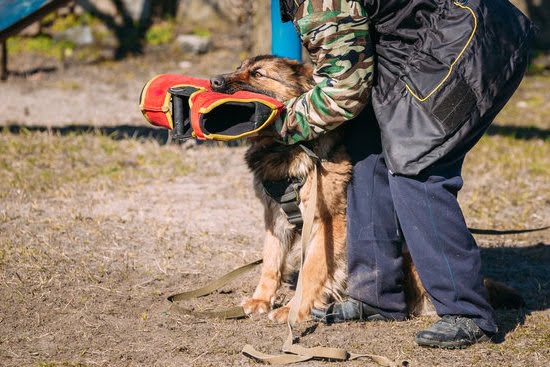Reactive behavior in dogs can be challenging to manage, especially when it comes to excessive barking. Understanding how to train a reactive dog not to bark is crucial for both the well-being of the dog and their owners. Dogs may exhibit reactive behavior for various reasons such as fear, anxiety, or territorial instincts. It is essential to identify the triggers that cause your dog to bark excessively before implementing any training techniques.
Common reasons why dogs bark excessively can include feeling threatened by strangers or other animals, separation anxiety, or a lack of socialization. By assessing the specific triggers for your dog’s barking, you can develop a targeted approach to address their reactive behavior. Positive reinforcement training techniques are often recommended for reducing barking in reactive dogs. By rewarding desired behaviors and ignoring unwanted ones, you can encourage your dog to exhibit calmer reactions in trigger situations.
In addition to positive reinforcement training, desensitization and counterconditioning exercises can help your reactive dog learn alternative responses to their triggers. These exercises involve gradually exposing your dog to their triggers in a controlled environment while providing rewards for calm behavior.
If you find that training your reactive dog not to bark is challenging, seeking professional help from a certified dog trainer or behaviorist may be beneficial. Consistency and patience are key when working with a reactive dog, as progress may take time but can lead to significant improvements in their behavior over time.
Common Reasons Why Dogs Bark Excessively
Dogs bark as a form of communication, but excessive barking can be a sign of reactive behavior that may need to be addressed through training. Understanding the reasons behind why dogs bark excessively is crucial in effectively modifying their behavior. Here are some common reasons why dogs may bark excessively:
- Loneliness or boredom: Dogs that are left alone for long periods of time or lack mental and physical stimulation may resort to excessive barking as a way to relieve their boredom or anxiety.
- Territorial behavior: Dogs often bark excessively to protect their territory or alert their owners of potential threats. This behavior can escalate quickly if not properly managed.
- Fear or anxiety: Dogs that are fearful or anxious may bark excessively as a coping mechanism. Identifying the triggers for their fear or anxiety is essential in addressing this behavior.
To train a reactive dog not to bark, it is important to first identify the specific triggers that cause your dog’s excessive barking. Once you have pinpointed the triggers, implementing positive reinforcement training techniques can help modify your dog’s behavior effectively.
- Positive reinforcement training techniques involve rewarding your dog for desirable behaviors, such as remaining calm in the presence of triggers that normally elicit barking.
- Desensitization and counterconditioning exercises can also be beneficial in reducing your dog’s reactivity towards certain stimuli. By gradually exposing your dog to their triggers and pairing them with positive experiences, you can change their emotional response over time.
- Consistency and patience are key when training a reactive dog not to bark. It is important to remain calm and composed during training sessions and provide clear cues for desired behaviors.
Seeking professional help from a qualified dog trainer or behaviorist can also provide valuable guidance and support in addressing your dog’s reactive barking. With dedication, consistency, and the right approach, it is possible to help your reactive dog overcome excessive barking and lead a happier, more peaceful life.
Assessing the Triggers for Your Dog’s Barking
Understanding the triggers that cause your dog to bark excessively is a crucial step in addressing and training this behavior. Dogs may bark in response to various stimuli, such as loud noises, unfamiliar people or animals, separation anxiety, or territorial behavior. By identifying the specific triggers that set off your dog’s barking episodes, you can begin to implement targeted training techniques to help reduce their reactivity.
Observing Your Dog’s Behavior
One way to determine the triggers for your dog’s barking is to closely observe their behavior in different situations. Take note of when and where they tend to bark the most, as well as what seems to set them off. By keeping a record of these observations, you can start to see patterns emerge and gain insight into what may be causing your dog’s reactive behavior.
Consulting With a Professional
If you are having trouble identifying the specific triggers for your dog’s barking or if their reactivity seems severe, it may be helpful to seek guidance from a professional dog trainer or behaviorist. These experts have experience working with reactive dogs and can conduct assessments to pinpoint the underlying reasons for your dog’s excessive barking. They can also provide personalized advice and training techniques tailored to your dog’s needs.
Implementing Training Strategies
Once you have identified the triggers for your dog’s barking, you can begin implementing training strategies aimed at reducing their reactivity. Positive reinforcement techniques, such as rewarding calm behavior and teaching alternative commands like “quiet” or “focus,” can help shift your dog’s response from barking to more appropriate behaviors.
Consistency and patience are key when training a reactive dog not to bark, so be prepared to dedicate time and effort towards helping your furry companion overcome this challenging behavior.
Positive Reinforcement Training Techniques for Reducing Barking
Understanding Positive Reinforcement Training
Positive reinforcement training involves rewarding your dog for good behavior rather than punishing them for bad behavior. This method focuses on reinforcing desired behaviors by providing rewards like treats, praise, or toys. By using positive reinforcement techniques, you can effectively train your reactive dog not to bark excessively.
Implementing Training Exercises
To begin training your reactive dog not to bark, start by teaching them alternative behaviors that are incompatible with barking. For example, teach your dog to “speak” on command and then teach them a “quiet” command as well. When they respond to the “quiet” command by stopping barking, reward them immediately with a treat and plenty of praise.
In addition, create situations where your dog is exposed to their triggers but at a distance where they do not bark. Reward calm behavior in these situations to help desensitize them to the triggers gradually. Consistent practice and patience are essential in this training process.
Seeking Professional Guidance
If you find that your efforts to train your reactive dog not to bark are not yielding results, it may be beneficial to seek help from a professional dog trainer or animal behaviorist. They can provide expert guidance on identifying the root causes of your dog’s reactivity and creating a personalized training plan tailored to your dog’s specific needs. Professional assistance can make a significant difference in successfully training a reactive dog not to bark excessively.
Implementing Desensitization and Counterconditioning Exercises
Reactive behavior in dogs can be challenging to address, especially when it involves excessive barking. Implementing desensitization and counterconditioning exercises can be effective ways to train a reactive dog not to bark in certain situations. Desensitization involves gradually exposing the dog to the triggers that cause barking, starting at a level where the dog is comfortable and slowly increasing the intensity.
Counterconditioning, on the other hand, focuses on changing the dog’s emotional response to the triggering stimuli. This technique involves pairing the presence of the trigger with something positive, such as treats or playtime, to create a new association. Over time, the dog learns that the trigger predicts good things rather than something to bark at.
One practical exercise for desensitization and counterconditioning is using a recording of the trigger sound at a low volume while rewarding your dog with treats or toys. As your dog remains calm, gradually increase the volume of the sound while continuing to reward calm behavior. This process helps your dog learn to associate the trigger with positive experiences instead of responding with barking.
| Desensitization and Counterconditioning Techniques | Benefits |
|---|---|
| Gradual exposure to triggers | Helps reduce fear and anxiety |
| Pairing triggers with positive experiences | Creates new associations for the dog |
Seeking Professional Help From a Dog Trainer or Behaviorist
One of the benefits of working with a professional is their ability to conduct a thorough evaluation of your dog’s behavior, identifying the underlying causes of their reactivity and barking. This assessment allows the trainer or behaviorist to devise targeted strategies that focus on addressing these root issues. By understanding why your dog reacts in certain situations, you can implement more effective training techniques that promote long-term behavioral change.
Professional trainers also offer guidance on proper training methods, communication techniques, and tools that can aid in managing your reactive dog’s barking. They can teach you how to use positive reinforcement, desensitization, and counterconditioning effectively to encourage calm behaviors while discouraging excessive barking. With their support and expertise, you can develop a comprehensive training plan that addresses all aspects of your dog’s reactive behavior, leading to significant improvements over time.
| Benefits of Professional Help | Why It Matters |
|---|---|
| Personalized training plans | Effective in addressing specific triggers |
| Thorough evaluation of behavior | Identifying root causes for targeted strategies |
| Guidance on proper training methods | Promoting long-term behavioral change |
Creating a Calm Environment for Your Reactive Dog
Reactive behavior in dogs, often manifested through excessive barking, can be a challenging issue for pet owners to address. One crucial aspect of training a reactive dog not to bark is creating a calm and stress-free environment for your furry friend.
Dogs are highly attuned to their surroundings and can easily pick up on the emotions of their human companions. Therefore, it is essential to maintain a peaceful atmosphere at home to help reduce your dog’s anxiety and triggers for barking.
To create a calm environment for your reactive dog, start by identifying any potential stressors or triggers in your home. This could include loud noises, chaotic interactions, or even certain objects that make your dog feel anxious.
Once you have identified these triggers, take steps to minimize or eliminate them from your dog’s environment. For example, if loud noises from construction work outside trigger your dog’s barking, consider using white noise machines or calming music to mask the sounds.
In addition to reducing triggers, provide your reactive dog with a safe space where they can retreat and relax when feeling overwhelmed. This could be a cozy corner with their favorite bed and toys or a designated room where they can unwind without any disturbances.
By creating a calm environment tailored to your dog’s needs, you can help alleviate their anxiety and prevent excessive barking episodes. Remember that consistency is key in maintaining a peaceful atmosphere for your reactive dog as they go through training on how to train a reactive dog not to bark.
Consistency and Patience
Training a reactive dog not to bark requires consistency and patience from the pet owner. It’s important to understand that changing a behavior in a dog takes time and dedication. Consistency means sticking to a training plan and following through with it every day, while patience means understanding that progress may be slow and setbacks can happen.
To effectively train a reactive dog not to bark, here are some key tips:
- Establish clear communication with your dog: Use verbal cues, hand signals, and body language consistently to help your dog understand what is expected of them.
- Set realistic goals: Determine achievable milestones for your dog’s progress and celebrate small victories along the way.
- Practice regular training sessions: Dedicate time each day to work on desensitization exercises and positive reinforcement techniques with your reactive dog.
Remember, every dog is unique, so what works for one may not work for another. It’s essential to tailor your training approach to suit your individual pet’s needs. With consistent effort and patience, you can help your reactive dog learn alternative behaviors instead of barking excessively in response to triggers.
Case Studies and Success Stories of Dogs Who Have Overcome Excessive Barking
Reactive behavior in dogs can manifest in various ways, one of the most common being excessive barking. Understanding why your dog is reacting this way is crucial in addressing and correcting the behavior. There are various reasons why dogs bark excessively, including fear, anxiety, territorial instincts, and even boredom. By understanding what triggers your dog’s barking, you can begin to work on training them to respond differently.
One effective way to train a reactive dog not to bark is through positive reinforcement techniques. This involves rewarding your dog for calm behavior and ignoring or redirecting their barking.
By consistently rewarding quiet behavior with treats, praise, or toys, your dog will start to understand that staying quiet leads to positive outcomes. It’s important to be patient and consistent with this training method as it may take time for your dog to make the connection between barking and the lack of reward.
In addition to positive reinforcement training, desensitization and counterconditioning exercises can also be beneficial in reducing a reactive dog’s barking. This involves gradually exposing your dog to their triggers in a controlled environment while providing positive experiences through treats or play.
Over time, your dog can learn that the presence of these triggers no longer warrants a reactive response. If you find that your efforts are not yielding results or if your dog’s reactive behavior is severe, seeking professional help from a certified dog trainer or behaviorist is recommended.
Additional Resources and Support for Training a Reactive Dog Not to Bark
Training a reactive dog not to bark can be a challenging but rewarding process for both the pet and the owner. By understanding the root causes of their reactive behavior, assessing triggers, and implementing positive reinforcement techniques, progress can be made in reducing excessive barking. Seeking professional help from a trained dog behaviorist or trainer can also provide valuable guidance in developing a tailored training plan for your furry friend.
Desensitization and counterconditioning exercises are effective tools in helping reactive dogs learn to remain calm in triggering situations. By gradually exposing them to their triggers in controlled settings and rewarding calm behavior, they can learn new, more positive associations with previously anxiety-inducing stimuli. Consistency and patience are key in this process, as breaking ingrained habits takes time and effort from both the dog and the owner.
Creating a calm environment for your reactive dog at home is crucial in supporting their training progress. Providing a safe space for them to relax, plenty of mental stimulation through toys and activities, and maintaining a routine can help reduce stress levels overall.
Remember that every dog is unique, so what works for one may not work for another. Each success story of dogs who have overcome excessive barking serves as inspiration that with dedication and the right support, any reactive dog can learn how to control their impulses and communicate more effectively.
Frequently Asked Questions
How Do You Stop a Dog From Reactive Barking?
One way to stop a dog from reactive barking is through training and behavior modification techniques. It’s important to identify the triggers that cause the barking and work on desensitizing the dog to those stimuli. Consistency, positive reinforcement, and patience are key when addressing reactive barking.
Can a Reactive Dog Be Cured?
While a reactive dog may not necessarily be “cured,” their behavior can be improved significantly through training and management. It’s essential to work with a professional trainer or behaviorist who can create a customized plan for your dog. With time, effort, and the right approach, a reactive dog can learn to better manage their reactions.
How Do You Desensitize a Reactive Dog?
Desensitizing a reactive dog involves exposing them gradually and safely to the triggers that cause their reaction. This process should be done in a controlled environment with positive reinforcement techniques.
By helping the dog associate positive experiences with previously negative triggers, you can slowly reduce their reactivity over time. Remember to progress at your dog’s pace to avoid overwhelming them.

Welcome to the blog! I am a professional dog trainer and have been working with dogs for many years. In this blog, I will be discussing various topics related to dog training, including tips, tricks, and advice. I hope you find this information helpful and informative. Thanks for reading!





